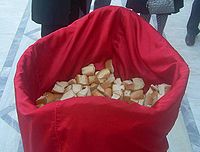| This article does not cite any references or sources. Please help improve this article by adding citations to reliable sources. Unsourced material may be challenged and removed. (December 2009) |

Pieces of antidoron.
The Antidoron (Greek: Ἀντίδωρον, Antídōron) is ordinary leavened bread which is blessed but not consecrated and distributed in Eastern Orthodox and other Christian churches. It comes from the remains of the loaves of bread (prosphora) from which portions are cut for consecration as the Eucharist during the Divine Liturgy. Eastern Catholic Churches of the Byzantine Rite also follow the practice of blessing and distributing antidoron.
Practice[]
Orthodox Christianity[]

The faithful preparing to receive Holy Communion. In the foreground are wine and antidoron which the communicants will partake of after receiveing the Body and Blood of Christ.
In the Orthodox Church, blessed antidoron is distributed after every Divine Liturgy. During the Prothesis (LIturgy of Preparation, at which the wine and bread are prepared on the Table of Oblation), the priest will bless each prosphoron as he takes it up to remove particles and place them on the diskos (paten). The remainder of the prosphora is cut into fragments and kept aside in a bowl or salver. In some jurisdictions it is the custom at the end of the Anaphora for the altar server to hand the bowl of antidoron to the priest who will make the Sign of the Cross with it over the chalice and diskos during the hymn, It is Truly Meet.
In the Russian Orthodox tradition, some of the antidoron is placed on a tray together with ordinary wine and is consumed by the communicants immediately after they receive Holy Communion.
At the conclusion of the Liturgy, the antidoron is distributed to the faithful as thy come up to kiss the blessing cross. Antidoron is not considered a sacramental and is explicitly not consecrated during the Eucharist.
Because the antidoron is blessed, it must be consumed only when fasting. The canonical regulations of the Orthodox Church state that the antidoron should be consumed before leaving the church, and that it should not be distributed to unbelievers or to persons undergoing penance before absolution, but variances are allowed. For instance, it is the custom in many Orthodox parishes to distribute the antidoron to visitors and catechumens as a sign of fellowship, or to bring a few pieces home to a relative who could not attend liturgy.
On Bright Saturday in place of (or in addition to) the normal antidoron, the Paschal Artos is cut up and distributed at the end of the Liturgy.
Easten Catholicism[]
In the Greek Catholic (Byzantine) churches of Austria and Hungary, the antidoron is presently given only on rare occasions during the year, chiefly on the Bright Saturday (Saturday in Easter week); while among the Greek (Roman) Catholics of Italy and Sicily it is usually given only on Holy Thursday, the Feast of the Assumption, that of Saint Nicolas of Myra, and at certain week-day masses in Lent; although according to some local customs it is given on other days. In other Eastern Catholic Churches of the Byzantine Rite it is distributed as in the Orthodox churches.
History[]
The earliest historical reference to this custom are in fact found in the Western Church. It is mentioned in the 118th letter of St. Augustine to Januarius (now known as the 54th letter in the new order), and in the canons of a local council in Gaul in the seventh century. Originally it was a substitute, or solatium for such of the faithful as were not properly prepared to receive Holy Communion or were unable to get to the Eucharistic Sacrifice. If they could not partake of the real Body of Jesus Christ, for instance because of not having fulfilled the obligatory fast or for being in a state of mortal sin, they had the consolation of partaking of the non-consecrated, liturgical bread which had been blessed and from which the portions for the real sacred consecration had been taken.
In the Eastern Church, mention of the antidoron began to appear about the ninth and tenth centuries. Germanius of Constantinople is the earliest Eastern author to mention it in his treatise, "The Explanation of the Liturgy", about the ninth century. Subsequent to him many writers of the Eastern Church (Balsamon, Colina, Pachemeros) have written on the custom of giving the antidoron.
While the practice of blessing and distributing antidoron still continues in the East, it was finally given up by the Western Church, and now only survives in the Roman Rite in the pain bénit given in French churches and cathedrals after High Mass, as well as in certain churches of Lower Canada, and occasionally in Italy, on certain feasts (e.g. of Saint Hubert). A similar custom also survives among the Syrian Christians (Christians of Saint Thomas) of the Malabar coast in India.
See also[]
- Liturgy of Preparation
- Table of Oblation
- Christmas wafer
This article incorporates text from the Catholic Encyclopedia of 1913, a publication now in the public domain. ru:Антидор uk:Антидор